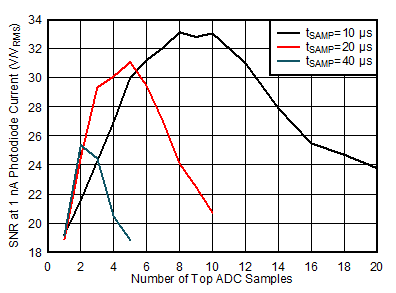SLVAEX3 October 2020 TPS8802 , TPS8804
4.3.4 Varying ADC Sample Rate
The ADC sample rate is determined by the microcontroller, clock speeds, and sample and hold times. While there may not be much adjustability of the ADC sample rate in a system, it is important to consider the effects of sample rate on the SNR. Three ADC sample rates are used to calculate the SNR, shown in Figure 4-17. Decreasing the ADC sampling interval from 40 μs to 20 μs to 10 μs increases the maximum attainable SNR from 25.4 to 31.1 to 33.1. The benefit of taking multiple top ADC samples decreases as the ADC sampling interval increases. As the ADC sampling interval approaches the LED pulse width, reduce the number of top ADC samples and increase τ1 and τ2.

| tLED=100 µs | τ1=15 µs | τ2=15 µs |